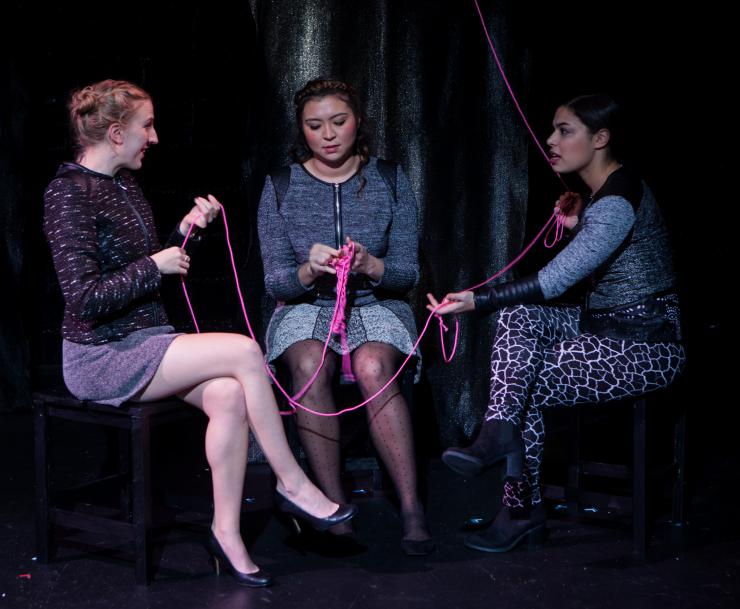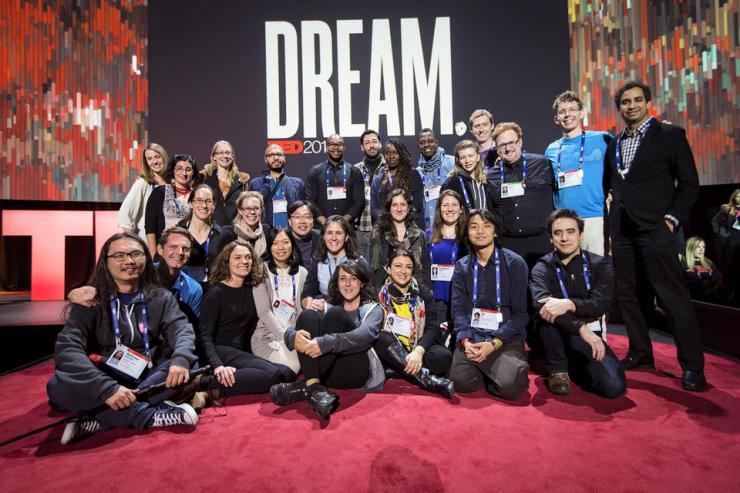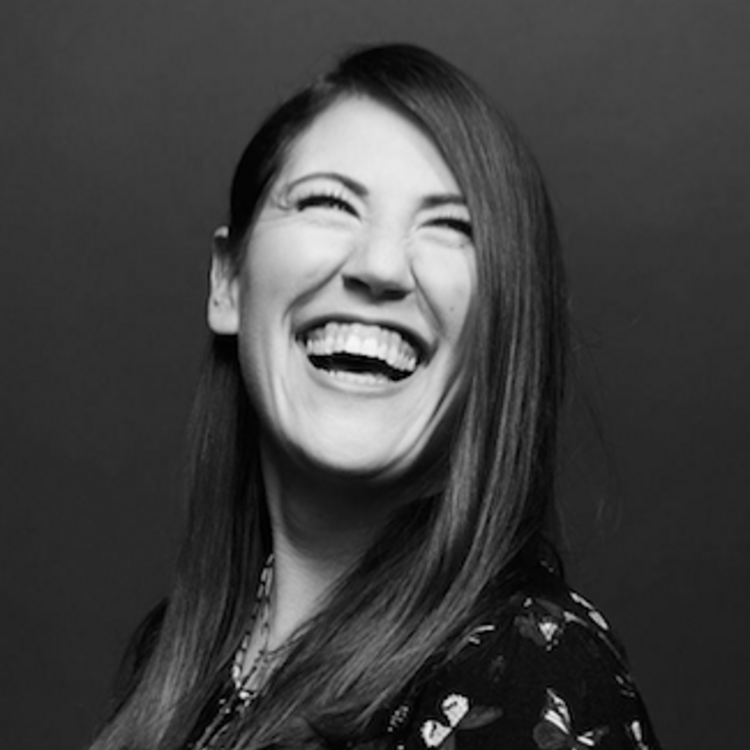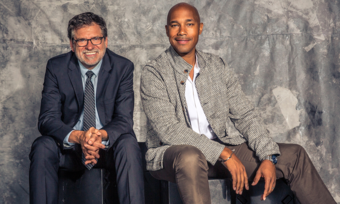The Fellowship of the TED
20 Theatre Lessons from the 2016 TED Fellows
There is a red circle on a stage. All attention is focused on this spot. Someone will appear and tell a story. The theatre feels like The Globe—wooden, vast, open, yet intimate. But the people who step onto that red circle are not actors. They will speak their own truths as scientists, designers, activists, artists, entrepreneurs. They are all of us—and they are here with an idea. An idea worth spreading.
This year I was honored to be the only theatre practitioner amongst the 2016 cohort of TED Fellows. TED (which stands for Technology, Entertainment, and Design) has become exceedingly famous for hosting compelling viral talks on the Internet. I spent a week in the comfortable dark of a theatre, listening to people tell stories onstage that were driven forward by stories shared backstage, on the road and at meals.
Sci-fi nerd that I am—I revelled in a week with asteroid hunters and biohackers. The Tardis had finally come for me. My epic adventure began, and I met people far different from myself whom I will cherish forever. I left the conference invigorated by the light of disciplines outside my own and want to share some unexpected insights gleaned that may be useful to the theatre community.

Consider the sort of world that we, theatre people, take for granted: in our world magic happens all the time.
“What happens if we forget our lines?” The other Fellows kept interrogating me.
“You just keep going,” I insisted.
“What? How?”
“I don’t know, you just do.” Comfortable in the magical mystery of the stage. I was thrilled when each TED Fellow presented their work brilliantly. Better yet, all of us learned from one another.
Here are twenty creative lessons gleaned from that week in Vancouver.
Sometimes the thing that works is the thing that shouldn’t. Creativity can be found absolutely anywhere.
Let’s start with Andrew Pelling, biohacker extraordinaire. What does it mean to be a biohacker? In Andrew’s words, “I challenge people to build the equipment they need out of the garbage I find, it’s a great way to foster creativity.” This man has turned apples into human ears. I kid you not. Apples into ears. So:
Lesson #1: Sometimes the thing that works is the thing that shouldn’t. Creativity can be found absolutely anywhere. I wish I brought a fraction of Andrew’s creativity to the rehearsal room each day.
My friend Bektour Iskender is an independent news publisher who founded Kloop, the fifth most popular news website in Kyrgizstan that’s also a journalism school. The media outlet is run by 14- to 25-year-olds who learn to “stand up for themselves, question authority, and set trends.”
Lesson #2: Youth can do our jobs as well as us. Sometimes, it’s important to let them have the opportunity.
Nicole Amarteifo is a television director and producer, who asks, “What can I do to fight the single story of Africa? What can I do to change the conversation of my country and my continent from the recurring theme of war, poverty, and famine.” She created Ghana’s own version of Sex and the City—An African City, which follows the sexual escapades of five women in Accra.
Lesson #3: Let’s build narrative shift out of the things that connect us all (like, love, sex, relationships)
As a Native artist and word person, excuse me while I gush over Keolu Fox a bit. This Native Hawaiian geneticist and indigenous rights activist invented a new word for us. “IndiGenomics (noun), genetic research to improve minority health through methods that respect indigenous knowledge.”
He was shocked to discover that 96 percent of genome studies that associate common genetic variation with specific diseases examined exclusively individuals of European ancestry. So he wants indigenous peoples to be educated about the pros and cons of genetic research so we can be partners in it, as opposed to serving as its subjects. Keolu restores faith in genetic research’s ability to be used for good.
Lesson #4: Create authentic partnerships on a community-by-community basis, so that resources can be used by each group of people on their own terms.
Majala Mlagui is a gemologist and mining entrepreneur who founded a social enterprise called Thamani which means “value.” The organization addresses mining policy regulations to benefit small-scale miners of semi-precious gemstones. She told us that, “Artisanal small scale miners produce 80 percent of global output, but they and the producing countries rarely get to see a commiserate percentage of the colored gemstone value.”
Lesson #5: How do we credit the people working at the beginning of a process when a product travels? Can we better connect the source to the ultimate output?
Sanford Biggers is an interdisciplinary artist working in painting, sculpture, video, and performance focusing on history and dialogue. His project, Lotus, embeds images from slave ships inside of the Buddhist lotus symbol. His body of work called BAM examines the pandemic shootings of young black men. Sanford points out, “Lotus and BAM are larger than US history. These killings have been going on for over 500 years.”
Lesson #6: The moment is always connected to those before it. How do we investigate the whole story?
Vanessa Wood is a brilliant electrical engineer making batteries cheaper, able to charge faster, last longer, and still be made quickly. She looks inside batteries to see what works. Ultimately it’s about pathways. How particles have to travel. If you want to improve speed, simplify your path. “All around better batteries means affordable electric transportation and the ability to store intermittent renewable energies.”
Lesson #7: If you want artists to be able to provide high quality services don’t make their route slow and difficult to traverse. Organization structure matters. How do we offer supportive pathways for improvements?
Free speech activist, Trevor Timm, reminds us that, “The press has the right to publish private information in the public interest.” Also, “Just as technology has allowed the government to circumvent reporters’ rights, the press can also use technology to protect their sources better than before.” Through new secure programs we can protect the way information is exchanged.
Lesson #8: How do we protect our own rights in an ever-expanding digital age?
Kiana Hayeri’s photography delicately captures how youth in Afghanistan hold onto hope. She says they are “striving to dream in the face of oppression.” Her work shows us youth just like us, who want the same things and risk their lives because of the importance of art and hope.
Lesson #9: We forget how beautiful is to be able to create. Let’s not forget it is something worth fighting for.
Then there is Prosanta Chakrabarty, an obsessive speciologist, spending his life dedicated to finding new species of cave fishes that “tell me about biology and geology, how land masses have evolved and moved by being stuck in holes, but also tell us about sight by being blind. Each cave fish has evolved differently and has a unique biological geological story to tell us.” Some are endangered, so they only have the chance to tell us something if we discover them before they go extinct.

Lesson #10: If you don’t listen to a small voice you may never see the bigger picture.
Jessica Ladd is a sexual health technologist fighting against the fact that “There’s a 99 percent chance sexual assailants will get away with it. There is almost no deterrent to assault in the United States.” She created a website with clearly written information about reporting options, including electronically reporting, a time stamped document, and the ability to submit an assault if someone else reports the same assailant.
Lesson # 11: There is an app for that. Even the most terrible problems can be begun to be solved if we start by asking people what they need.
Carrie Nugent is an asteroid hunter. She discovers new asteroids every day. There were 1,556 near earth asteroids discovered just last year. Focused efforts to catalogue asteroids mitigate their threat. Carrie reminds us that, “We are the only species able to understand calculus and build telescopes. If we find it in advance, we can nudge it out of the way."
Lesson #12: Carrie will save us from the asteroids and she names them after important socio-political figures. (Someone please make a play about this.) But also, you can avoid the end of the world if you just map out possible obstacles in advance.
Writer and Filmmaker Mitchell Jackson reminded us that “race is a biological myth,” that whiteness was invented by America’s colonizers. “If you could choose to abolish white power, white privilege, white supremacy would you do it? Would you also abolish blackness?” Difficult questions. Mitchell argues that, “By claiming blackness as who we are” we have been coerced into acknowledging whiteness as higher status … so the most revolutionary thing we can do is refuse it as a racial category and idea.” How do we return to being fellow human beings?
Lesson #13: Sometimes to address problems we need to separate ourselves from the present cultural moment and remember the rules were not there forever.
Laura Indolfi is a biomedical entrepreneur working on treatments for pancreatic cancer, the third cause of cancer death. The pancreas is in a hard to reach location so the only option is chemo, but there are very few blood vessels in the tumors for delivery. “We don’t need to spend more money on drugs, but on the way it is delivered.” She is pioneering a localized drug delivery process that goes right to the tumor, reducing systemic toxic effect.
Lesson # 14: We can go directly to the problem. Sometimes being direct is the only way to stop a problem. The roundabout route can poison the whole system.
Musician and Filmmaker Samuel “Blitz the Ambassador” Bazawule asked, “Have you ever wondered what music would sound like if you took the bass melody, gave it to the drums, or took the drum melody and gave it to the horns, or perhaps took the string melody and gave it to the guitars?” When he changed things up by accident, he began to find his own unique sound.

Lesson #15: Sometimes wrong is right.
Amanda Nguyen (policy maker) just created a Sexual Assault Survivor Bill of Rights.
Survivors are often revictimized by the system, one of the many steps of which is a three to seven-hour long examination called a rape kit. She said, in “Massachussetts there is a six-month deadline for survivors to report the crime before that kit can be destroyed, even if the statute of limitations to report that crime is fifteen years … every six months a survivor needs to fight to hold on to evidence.” These rules are different in every state. “Justice cannot depend on geography.”
Lesson #16: In Amanda’s words, “You have agency over what happens in your own states in your own towns.”
A solar energy researcher, Sam Stranks, works with perovskite, a material that “has let us rethink what we can do with silicon-based solar panels on buildings. They can be colorful/opaque or partly transparent, which means we can make beautiful buildings in which the solar is part of the design.” Unlike, the clunky expensive option people used to think of as solar energy, these particles are lightweight, cheap, and visually appealing.
Lesson #17: We can make things cleaner, cheaper, and more beautiful. Sometimes we do not have to compromise. If we keep looking for solutions. They can be as efficient as nature itself.
Step aside Doctor Who, Helene Morlon is a time traveler who does it with math. She’s a biodiversity mathematician who uses math and supercomputers to study the evolution of species and predict what might happen to them. She reconstructs the present to the past, looking at which species diverge and uses math to look at potential. “If all the species that are endangered today go extinct we will lead the sixth mass extinction event … nothing in biology makes sense except in the light of evolution.” She works to preserve our future.
Lesson #18: Travel back in time to understand the future. Everything is connected.
My friend Michael Twitty is a culinary historian, who examines the intersection between culinary appropriation and culinary justice. He defines culinary justice as “the idea that oppressed peoples have the right to not only be recognized for their gastronomic contributions but they have the right to their inherent value, to derive from them uplift and empowerment.” This distinction between appropriation and justice from a culinary perspective relates to our use of stories.
Lesson #19: Our traditions hold value for us. They can transcend difference, but they should not be casually appropriated without regard to their meaning or history.
Nikhil Pawa is a digital rights activist who spoke about the battle for net neutrality in India. “Who gives us permission to create? The battle for net neutrality is a battle for internet freedom.” Facebook allowed some sites to be accessed for free in India but only on their terms. A volunteer driven effort fought to retain freedom of the Internet. Different websites should not cost different amounts of money to access at different speeds. “Now everyone in India has an opinion on net neutrality and knows what’s at stake, so that policy cannot be made in a vacuum.”
What if an ensemble was made up of more than performers? What if it contained activists, scientists, artists?
Lesson #20: The public needs to be made aware.
Why does this all matter to theatre?
What if an ensemble was made up of more than performers? What if it contained activists, scientists, artists? What if we practiced the fellowship of TED, with ideas cross-pollinating the same space? Think about what creative work would be possible. There is a red circle on a stage. And everyone gets to share their stories. These are only twenty lessons. Maybe we should share more.









Comments
The article is just the start of the conversation—we want to know what you think about this subject, too! HowlRound is a space for knowledge-sharing, and we welcome spirited, thoughtful, and on-topic dialogue. Find our full comments policy here